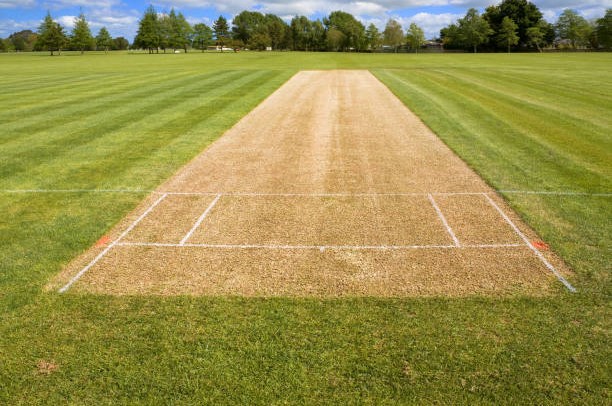Cricket Ground: Cricket, one of the most beloved sports worldwide, is played on an expansive playing field known as a cricket ground. While the game itself may seem fairly simple with its bat and ball action, the size and layout of the cricket ground play a crucial role in influencing the style and outcome of a match. The dimensions of the ground, the size of the boundary, and the layout of fielding positions all affect various aspects of the game, including batting, bowling, fielding strategies, and ultimately, the result of a game.
Cricket Ground: In this article, we will explore how the size of a cricket ground impacts the game, focusing on factors such as scoring opportunities, fielding strategies, and bowling performance. We’ll also provide an in-depth look at how these elements vary with different ground sizes, offering examples from international cricket to illustrate these points.
The Basics of a Cricket Ground

Cricket Ground: A cricket ground is a large, circular or oval-shaped field, with specific areas marked for batting, bowling, and fielding. The playing area is typically surrounded by a boundary, which can either be a rope, a fence, or a line drawn on the ground. The distance from the center of the pitch to the boundary is essential in determining the layout and flow of the game.
Cricket Ground: According to the Laws of Cricket, the maximum distance from the center of the pitch to the boundary should not exceed 85 meters, although the ideal distance varies depending on the type of match and the ground itself. This distance can significantly impact the number of runs scored, fielding placements, and even the type of strategies that teams employ.
Size of the Ground and Its Effect on Batting
The size of the cricket ground has a direct impact on how easily batsmen can score runs. In general, the larger the ground, the more challenging it is for batsmen to hit boundaries. On smaller grounds, batsmen have a higher chance of clearing the boundary with aggressive shots, as the distance to the boundary is reduced, making it easier to score four or six runs.
In comparison, larger grounds require a higher level of power and technique from the batsman to clear the boundary. On bigger grounds, batsmen are often forced to settle for singles and twos, as hitting the ball to the boundary becomes significantly harder. This encourages more strategic shot selection and can lead to longer innings.
Impact of Ground Size on Batting
| Ground Size | Boundary Distance | Impact on Batting Style | Scoring Opportunities |
|---|---|---|---|
| Small Ground | 55-65 meters | More aggressive, hitting for boundaries easier | Higher number of boundaries (4s & 6s) |
| Medium Ground | 65-75 meters | Balanced between aggression and caution | Mix of boundaries and singles |
| Large Ground | 75-85 meters | Focus on placement, harder to hit for sixes | More singles and twos, fewer boundaries |
Size of the Ground and Its Effect on Bowling

The size of the ground also has a significant impact on how bowlers approach their strategy. On smaller grounds, bowlers tend to face greater pressure due to the shorter boundary distances. Every small mistake in line or length can result in a boundary. This forces bowlers to be extremely precise with their deliveries, and they must make use of variations such as yorkers, slower balls, and cutters to limit runs.
On larger grounds, bowlers have a little more margin for error, as hitting boundaries becomes more difficult. As a result, bowlers on large grounds can afford to be more aggressive with their line and length, attacking the stumps and focusing on getting batsmen out. Fast bowlers, in particular, benefit from the larger boundaries as they can rely on pace and bounce to keep the batsmen from hitting boundary shots.
Impact of Ground Size on Bowling
| Ground Size | Boundary Distance | Impact on Bowling Strategy | Challenges for Bowlers |
|---|---|---|---|
| Small Ground | 55-65 meters | More defensive, focus on accuracy | Pressure to avoid boundary balls |
| Medium Ground | 65-75 meters | Balanced, mix of attacking and defensive | Manage both aggression and control |
| Large Ground | 75-85 meters | More aggressive, focus on attacking | Need to control pace and length |
Fielding Strategies and Ground Size
The size of the cricket ground also determines how fielders are positioned. On smaller grounds, fielders are more likely to be placed in positions where they can cover the boundary quickly. With reduced boundary distances, it becomes crucial to have fielders who can prevent the ball from crossing the ropes, particularly in the outfield. This is why you often see more fielders stationed in the deep (the outfield) on smaller grounds.
On larger grounds, fielders are spaced out over a greater distance, and there is a larger area to cover. As a result, there may be fewer fielders in the deep, and the focus shifts to containing the batsmen with accurate throws and sharp fielding in the inner ring. Additionally, on larger grounds, there is usually a greater emphasis on the wicketkeeper and slip fielders to create pressure with aggressive bowling.

Fielding Strategies on Different Grounds
| Ground Size | Boundary Distance | Fielding Strategy | Key Focus in Fielding |
|---|---|---|---|
| Small Ground | 55-65 meters | More fielders in deep positions | Boundary prevention, quick throws |
| Medium Ground | 65-75 meters | Balanced, mix of fielders in both deep and inner ring | Control both inner and deep areas |
| Large Ground | 75-85 meters | Fewer fielders in the deep, more focus on inner ring | Quick, sharp fielding, strategic placements |
Strategic Implications for Different Formats
The size of the cricket ground has a profound influence on different formats of the game, such as Test matches, One Day Internationals (ODIs), and Twenty20 (T20) cricket.
Test Cricket: In Test cricket, the size of the ground tends to have less influence on the outcome due to the longer format of the game. A larger ground may give bowlers the opportunity to build pressure over long spells, but it doesn’t necessarily result in a major difference in batting or bowling strategies, as runs are accumulated over a longer period.
One Day Internationals (ODIs): The size of the ground becomes more significant in ODIs due to the limited overs. Batsmen in ODIs often aim for aggressive batting, and smaller grounds lead to more boundaries and higher run rates. Larger grounds force batsmen to adjust their approach, leading to slower scoring but also fewer chances of getting out.

Twenty20 (T20): In T20 cricket, the size of the ground plays a pivotal role due to the extremely short nature of the game. Smaller grounds often lead to high-scoring games with frequent boundaries, while larger grounds can curb aggressive batting and lead to lower scores. The tactics shift to running between the wickets and rotating strike effectively.
The size of a cricket ground can dramatically affect the style and outcome of the game. Smaller grounds favor aggressive batting and attacking play, while larger grounds benefit bowlers and fielders by providing more room to defend against boundaries. The strategies in batting, bowling, and fielding vary depending on the size of the ground, and the conditions often require teams to adjust their tactics accordingly. Whether it’s Test cricket, ODIs, or T20 matches, understanding the dynamics of the ground size is crucial for formulating successful strategies.
This constant interaction between the ground’s dimensions and a team’s tactics is what makes cricket such an exciting and ever-evolving game.
